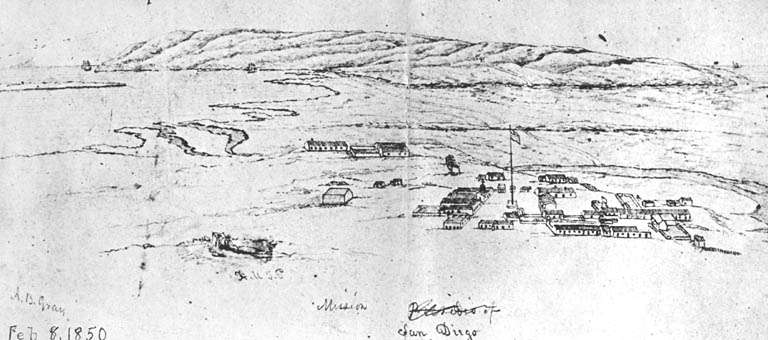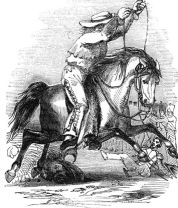 |
Mexican Land Grants |
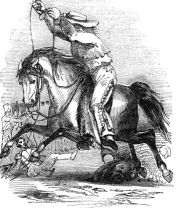 |
 |
Mexican Land Grants |
 |
| Links: History of San Diego | The Decline of the Californios | Land Grants in Alta California | |
The Province of Upper California encompassed the present day states of California, Nevada and Utah as well as parts of four additional states. The Mexican Constitution of 1824 designated this area as Alta California Territory with Monterey as the capital. In 1836 Alta California, shown on the map below in pink, was recognized as a department of Mexico. Its Spanish-descended population was never large, not exceeding 10,000 as late as 1845.
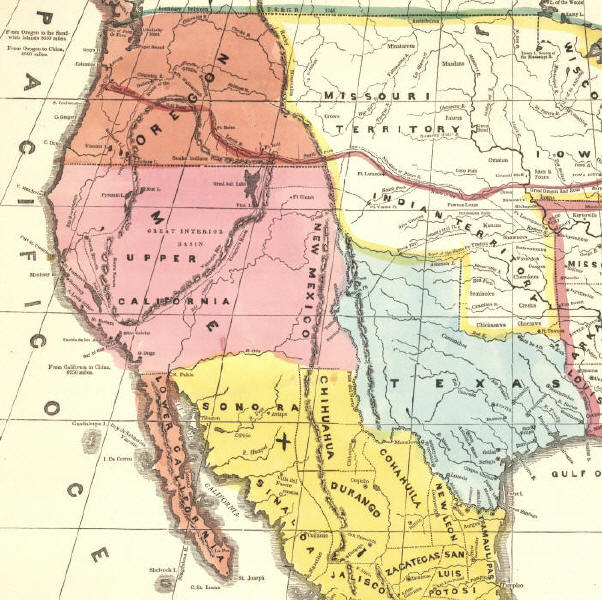
During the Spanish period, 1769-1821, the government had made grants of land in California, though none in San Diego County. These grants, about 30 in all, were, unlike the later Mexican grants, made only for the life of the recipient, the crown retaining the title. They were, in essence, only grazing rights. The land was granted "to encourage agriculture and industry, reward soldiers, and to provide for settlers who held no property" - from "Grants of Land in California Made by Spanish or Mexican Authorities".
Subsequent to the Revolution of 1810-1821, the new Mexican government sought to encourage settlement in Alta California and to break the land monopoly of the missions. In 1824 the Mexican Colony Law established rules for petitioning for land grants in California and by 1828 the rules for establishing land grants were codified in the Mexican Reglamento. In 1833 the Secularization Act repossessed the lands that had been granted to the missions by the Spanish government. The missions subsequently shuttered and fell into decay. The government issued many large land grants of land to the Californios, a total of 270 before 1846, including 33 in San Diego county.
To receive a free grant of land, the government required compliance with the following four steps:
"1. The first step was the submitting of a petition by an
applicant, containing the name, religion, residence,
occupation, and the size of the family. Along with a
land description and, at times, a map of the tract
(diseno). The diseno (map) and land description were
usually very vague, calling to sloughs, trees, hills, and
other features which were not very permanent.
2. The second step was the inquiries by officials into the
availability of the land, the character of the applicant, and the posting of the petition in case another party had
objections to the approval of the application.
3. The third step was the lnforme which was usually a
separate document or a note appended to the original
application, stating the findings of the officials in
Step Number 2. This third step usually entailed the
actual grant of land or refusal of the grant of land.
4. The fourth and final step was the confirmation of the
grant by the Viceroy. This final step made the title to
the land perfect. The applicant or grantee was given possession by the Alcalde (local judge) who caused the
grantee to pull up grass, throw stones, break twigs, and
exclaim, "Viva el Presidente y la Nacion Mexicana" ( long
live the President and the Mexican Nation). During the
Mexican era, these four steps were also used with minor
alterations." - from "Grants of Land in California Made by Spanish or Mexican Authorities"
Because the disenos were usually hand drawn and without the benefit of specialized surveying tools, they were often rough, approximate sketches, see below. Recipients of grants were usually well connected people, including friends and relatives of the current governor.
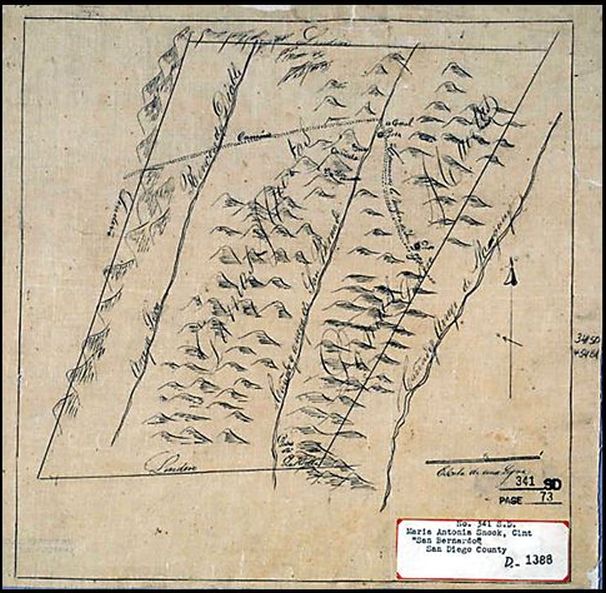
The land grants, given freely, were permanent transfers of full property ownership and inheritance rights. However, several requirements were laid on grantees: The grant had to be surveyed and marked; The grantee could not subdivide or rent out the land; The land had to be used for grazing or cultivation; Some kind of residence had to be built on the land within a year of the grant; Public roads through the property could not be closed. These requirements were rarely enforced and since there were few surveyors in the region at this time, most grantees did not have the boundaries of their property established.
The grants were usually of two square leagues in area, or 8,856 acres, though much larger grants were also made. A league, derived from the Roman leuga, was a measurement of the distance that a man could walk in an hour.
When grants were made from former mission lands the new owners also received the mission's large lifestock herds and native labor force. The latter were held in peonage, a kind of semi-slavery. If they ran away, they were hunted down and returned to the rancho. They were unpaid, receiving only food and shelter, and their death rate was estimated to be four times that of the Californios. In 1841 a visiting U.S. naval officer observed that the rancheros valued an Indian's life scarcely more than "'that of one of the wild cattle" - from "California: An Interpretive History" by James Rawls and Walton Bean.
Most of the grants became ranchos dedicated to raising cattle. The owners, often the sons or grandsons of common soldiers from the presidios, styled themselves landed gentry, an aristocracy patterned on the grandees of Old Spain.
"Theirs was the graciousness of men and women to whom gaining a living was no problem. They were as hospitable as they were proud, as generous as they were impractical, as chivalrous as they were jealous of honor, and as kindly as they were easygoing.
In many ways the years of the Dons resembled another pastoral epoch of American history - the ante-bellum days of the South. Both modes of life rested on vast land holdings and a large and inarticulate menial class . . ." - from The History of San Diego Ranchos by R. W. Brackett
The cattle business in Alta California was principally for the hides. These were sold to merchant ship captains who transhipped them to New England where there was a burgeoning shoe manufacture. See Richard Dana's "Two Years Before the Mast" for an account and a glimpse of 1840's San Diego. The market for beef did not develop until the population of California began to increase due the the 1849 gold rush. At that point cattle drives north to the San Francisco region began.
In 1823, prior to passage of the Secularization Act, the Mexican governor, Luis Antonio Arguello, made the first land grant in San Diego county to Captain Francisco Maria Ruiz. Ruiz was given a square league of land, or 4,400 acres, in Penasquitos (Little Cliffs) canyon. It included the eastern end of the canyon and mesas to the north and south that are now the suburbs of Rancho Penasquitos and Mira Mesa. The mission padres wrote a letter to the governor stating that this land was theirs, used by the mission for sheep grazing, vineyards, and orchards, but their objections were ignored. Captain Ruiz was the commandant of the San Diego Presidio. He had served in the Mexican army during the revolution and the grant was a reward for his service.
In 1834 Ruiz petitioned for and received another square league of land at the western end of the Penasquitos valley.
One of the adverse effects of the land grants was to deplete Old Town San Diego of its population. In 1834, after receiving a petition from 432 residents (out of a population of 520) for a civilian government, San Diego was recognized as a pueblo and granted the right to municipal government and its own mayor, or alcalde. However, the town's population had dropped to just 150 by 1838 due to the movement of people to the ranchos and attacks by the natives. The town lost its status and its mayor and was subsequently administered by a Justice of the Peace as a sub-prefecture of the pueblo de Los Angeles. Alfred Robinson visited San Diego in 1840 and observed that,
"everything was prostrated, the Presidio ruined, the Mission depopulated, the town almost deserted, and its few inhabitants miserably poor."In 1846 the town's population had grown to 350.
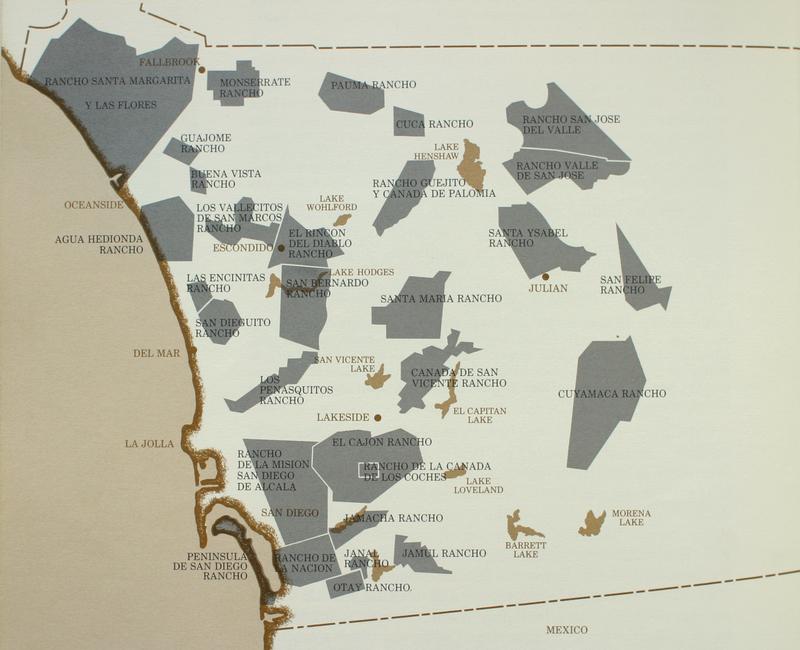
Of course, the native population was also adversely effected. They had been told that their lands were held in trust by the missions and would be theirs again after a period of instruction. The latter was generally held to be about 10 years, but after 40 years the padres still felt the natives "needed just a little more education." The natives believed the land should have been returned to them upon secularization and they resented the Californios for receiving any of it. The secularization act had stipulated that one half of the mission lands would be returned to native converts. However, this was accomplished only on a very limited basis. In San Diego this comprised three pueblos, San Dieguito, San Pasqual and Las Flores (the Kumeyaay pueblo of San Pasqual was established on 16 November 1835). The Kumeyaay subsequently revolted and throughout 1836 and 1837 Indian attacks reached new heights, forcing the evacuation of ranchos and several times threatening San Diego itself. Violence continued through 1840 threatening the community and forcing the Californios to abandon their ranchos again and again. After 1842 the attacks subsided and more land grants were approved, including that of Rancho San Bernardo, Rancho El Rincon del Diablo (Escondido) and Rancho San Marcos to the Juan B. Alvarado family.
The Spanish-descended population of Alta California, despite their land grants, were also displeased. They unsuccessfully rebelled against rule from Mexico City in 1836 and again in 1845. Their resentment was based on the imposition of Governors who had little knowledge of local conditions and with laws passed without consideration of the Californios' concerns. This usually meant they wanted laws favoring the rancho owners.
| California Uprisings Against Mexican Rule
1831 Manuel Victoria became Civil Governor of Alta California in 1831. He served until January 1832, when the people rose in rebellion against his arbitrary rule and drove him out of the territory. He was succeeded by Pio Pico, the leader of the uprising and the head of the legislature, the Departmental Assembly. 1836 Juan Bautista Alvarado and Jose Castro led a movement for independence of Alta California in 1836 in which they successfully deposed Governor Nicolas Gutierrez. They declared California's independence and created a new flag and constitution. Negotiations with the Mexican central government in 1837 resulted in an end to California independece, but with greater local automony. Alvarado was recognized as governor and Castro as Lieutenant Colonel of militia. Alvarado served as Governor of Alta California from 1837-42. 1845 Alvarado's governership was followed by that of Mauel Micheltorena, who forcibly replaced him. Widely hated, he was deposed in 1845 by the Californians after his forces were defeated at the Battle of Providencia. San Diegan Pio Pico was again acclaimed as Governor, with Jose Castro as Commandante General of military forces. Pico ruled the region south of San Luis Obispo with his capital in Los Angeles. The area to the north of the pueblo of San Luis Obispo was under the control of Castro, with headquarters near Monterey, the traditional capital and, significantly, the location of the Customhouse. Pico and Castro disliked each other personally and soon began escalating disputes over control of the Customhouse income. Meanwhile, decrees issued by the central government in Mexico City were, while often acknowledged and supported with proclamations, ignored in practice. In 1846, during the Mexican-American War, both Pico and Castro fled California. |
In the peace treaty that ended the Mexican-American War in 1848 and established U.S. rule, the American government promised to honor the legitimate land claims of Mexican citizens. However, since few of the latter could show an adequate survey they were subjected to long, expensive legal battles to prove their claims. Of the 813 grants ultimately claimed, the Land Commission confirmed 604.
The rancho owners were also subjected to a land tax by the new government, something common to Americans, but which they had not had to pay previously. Being land-rich but cash-poor, many could not afford to pay and fell into debt.
While the Californio rancho owners experienced a decline in economic status, political power and social influence after the war, they did enjoy what has been described as an "Arcadian" era in the 1850s due to the increase in the price for cattle, caused by the Gold Rush. However, the San Diego ranchos were located too far to the south to benefit from this. Also, the local weather turned very dry and hot resulting in great hardships for all county residents. The economy of San Diego declined throughout the period and many of the ranchos would be sold off and subdivided.
In the 1850 census there were still less than 1,000 non-native inhabitants in San Diego county.
